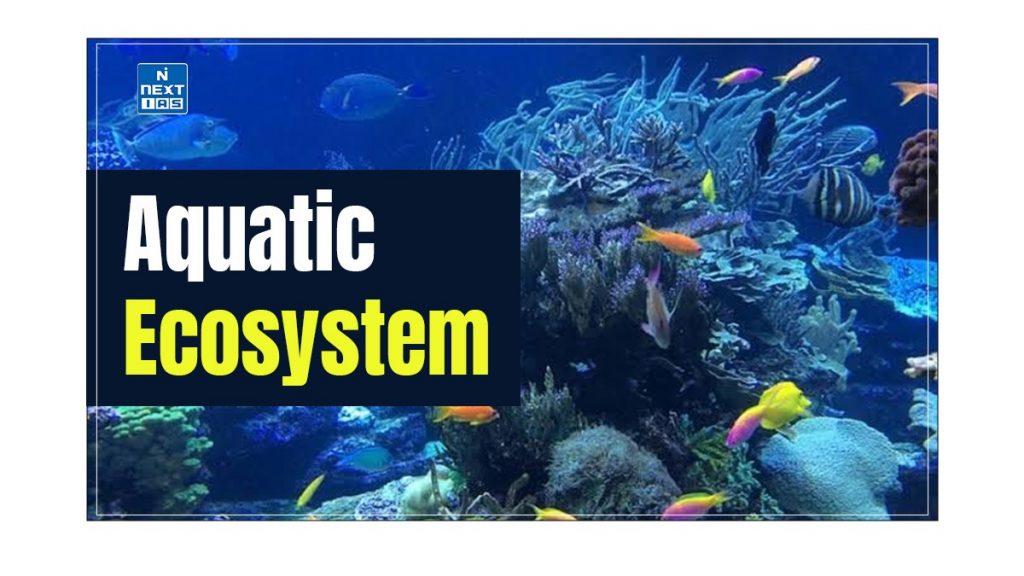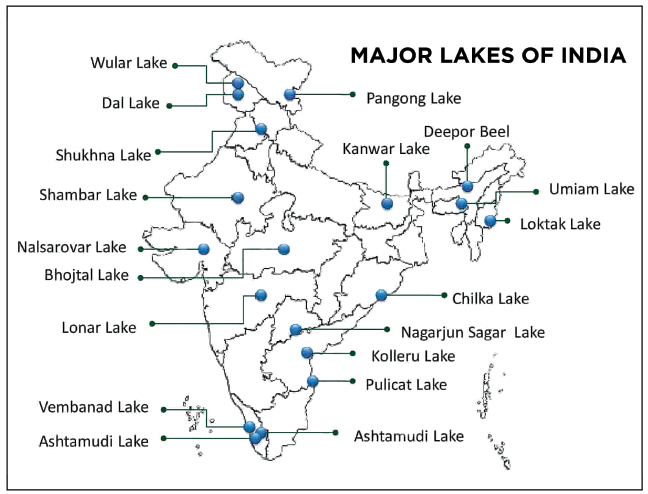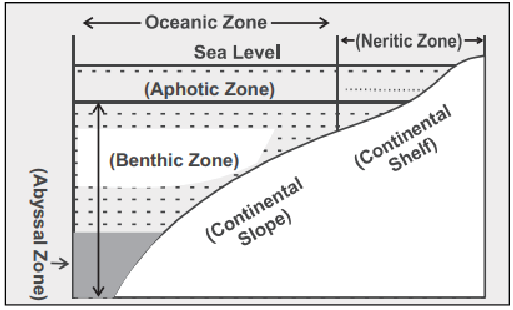
Aquatic Ecosystems, encompassing a wide variety of life forms and habitats, play a crucial role in the Earth’s ecological balance. A thorough understanding of these ecosystems is essential for comprehending ecological principles and addressing environmental challenges. This article aims to study in detail the Aquatic Ecosystem, its meaning, and various types, including Freshwater Ecosystems, Marine Ecosystems, Estuaries, Mangroves, Coral Reefs, etc.
What is Ecosystem?
- An ecosystem is a functional unit of nature wherein a community of living organisms interact among themselves and with the surrounding physical environment.
- An Ecosystem varies greatly in size and may be as large as a forest or sea or as small as a small fishpond, which provides a home for plants and other small animals.
Read our detailed article on the Basic Concepts of Ecosystem.
What is Aquatic Ecosystem?
An aquatic ecosystem is an ecosystem where interactions among the different organisms and their environment take place in water bodies.
Types of Aquatic Ecosystems
- Based on their salinity levels, these are, broadly, two types of aquatic ecosystems:
- Freshwater Ecosystems, and
- Marine Ecosystems.
- Apart from these, there are some other types of aquatic ecosystems, which are widely found in India, such as – Estuaries, Mangroves, Coral Reefs, Seagrasses, etc.
Each of these aquatic ecosystems is discussed in detail in the sections that follow.
Freshwater Ecosystem
- Freshwater ecosystem is defined as an aquatic ecosystem having salt concentration usually less than 1% and is continuously cycling.
- For example, pond ecosystem, lake ecosystem and river ecosystem.
- Only 0.8 per cent of the earth’s surface is covered by the freshwater ecosystem.
Categories of Freshwater Ecosystems
Based on the mobility of water in these ecosystems, the freshwater ecosystem can again be categorised into two types:
- Lentic Freshwater Ecosystems, and
- Lotic Freshwater Ecosystems.
Lentic Freshwater Ecosystem
- These are the systems where the water is stagnant and has no exit.
- These are generally formed in a depression on the earth’s surface where water from other sources accumulates.
- Lentic systems, therefore, are closed systems.
- These ecosystems experience stratification as the water is stagnant.
Lotic Freshwater Ecosystem
- These ecosystems are characterised by rapid unidirectional flow of water.
- For example, rivers and streams, springs, mountain brooks etc.
- These ecosystems serve the function of transferring the surplus rainwater back to the ocean.
- As compared to the lentic ecosystem, plant diversity is low in the lotic freshwater ecosystem, as the moving water poses a survival threat to plants, especially the big ones.
Types of Freshwater Aquatic Ecosystems
- The freshwater ecosystems can also be classified into lakes, flood ponds and rivers.
- Each of these freshwater aquatic ecosystems is discussed below in detail.
Lakes
- A body of water is considered a lake when it is inland and not part of the ocean.
- It is also deeper than a pond.
- It is an area of variable size filled with water, localised in a basin that is encircled by land and some rivers or other outlets that feeds or drains the lake.
- Generally, natural lakes are found in mountainous areas, rift zones, and areas with ongoing or recent glaciation.
- Examples: Loktak lake, Wular lake etc.
Flood Ponds
- Most of the ponds are filled up during the rainy seasons only and are dried up in other seasons.
- In its dry phase, many life forms, such as the algae and microscopic animals, aquatic insects, snails, and worms etc. remain dormant and become active in the monsoon season.
Rivers
- These aquatic ecosystems are the flowing water bodies on land surfaces, carrying surplus water of rain to discharge into an ocean.
- For example, river Yamuna, Ganga and Tapti, Krishna, Cauvery, Narmada etc.

Marine Ecosystem
- This type of aquatic ecosystem includes oceans, estuaries, lagoons, mangroves, coral reefs, the deep sea, and the sea floor.
- These ecosystems cover around 71 per cent of the earth’s surface.
- Marine ecosystems have high concentrations of salts.
- As we move from coastal areas to the ocean, the depth of water increases, and thus different types of ecosystems develop.
- The producers in this ecosystem vary from microscopic algae to large seaweeds.
- There are millions of zooplankton and a large variety of invertebrates on which live fish, turtles and marine mammals.
- The top layer of the ocean is highly productive and the substratum of the ocean is less productive.

Zones in Marine Ecosystem
Marine ecosystems are stratified into various zones based on depth, light penetration, and ecological characteristics.
Photic Zone or Euphotic Zone
- Extends from the surface to about 200 meters (656 feet).
- Receives sufficient sunlight for photosynthesis.
- It is the warmest layer, which supports a diverse range of photosynthetic organisms like phytoplankton and algae and is the most biologically productive zone.
Disphotic Zone
- Extends from the lower limit of the euphotic zone (around 200 meters) to about 1000 meters (3280 feet).
- Receives minimal sunlight, insufficient for photosynthesis but enough to influence the behavior of some organisms.
- It acts as a transitional area between the photic and aphotic zones and supports species adapted to low-light conditions.
Aphotic Zone
- Begins around 1000 meters and extends to the ocean floor.
- No sunlight reaches this zone.
- It houses a dark, cold, and high-pressure environment and relies on organic matter falling from upper layers (marine snow) for sustenance.
Factors Affecting Marine Ecosystem
The organisms in marine ecosystems are not evenly distributed and depend on many factors, as explained below.
- Availability of Light: The majority of biodiversity is present in the zones where sunlight is present.
- Proximity to Land: Areas close to the lands are rich in nutrients brought about by many rivers.
- This is why the greatest diversity of marine organisms is typically found in the tidal zone close to the shore.
- Depth of Water: It plays a significant role as the pressure increases with the depth.
- Thus, organisms at great depths show adaptation to this increased pressure.
Variants in Marine Ecosystem
Open Marine Ecosystems
- This is also known as the Euphotic Zone and extends upto a depth of around 150 meters.
- Open Marine Ecosystem includes types of sea life that float or swim, such as plankton, algae, jellyfish and whales.
Ocean Floor Ecosystems
- Marine life exists not only in the open ocean waters but on its floor as well.
- Being at greater depths, sunlight cannot penetrate to this region, and organisms inhabiting this area rely on the sinking of organic matter above for survival.
- Most of these organisms are small in size, and generate their own light to attract or find food sources.
- Examples of ocean floor ecosystem includes invertebrates such as crabs, jellyfish, squids, corals, sperm whales, etc.
Estuaries
- Estuaries are the meeting place of rivers carrying freshwater and silt load with the saline water of the oceans.
- This aquatic ecosystem represents an ecotone, a transition zone, between the freshwater ecosystem and the marine ecosystem.
- These ecosystems are highly dynamic as the river is continuously bringing the load with it and the amount of load is also varying.
- Examples of estuaries are coastal bays, tidal marshes, lagoons and deltas.
- As it is continuously replenished by the sediments brought by the freshwater sources and also from the ocean, they tend to have very high level of nutrition which in turn supports very high diversity of organisms.
- This biodiversity is generally higher than both the freshwater and marine water ecosystem as it has characteristics of both the ecosystems.
- Mangrove forests are found near the mouth of the rivers and deltas.
- Example Sundarban delta.
Threats to Estuaries
These ecosystems are under grave threat due to a variety of reasons which include:
- population growth and changing land use patterns, putting an excessive burden on the ecosystem,
- polluted runoff from human activities like waste from Industries and urban centres,
- construction of dams blocks upstream and downstream passages for migrating fish, and global warming, leading to submergence of coastal areas, etc.
Mangroves
- Mangroves are a type of tree species that grow in intertidal salty environments near the mouths of the delta of rivers along the coasts because they can tolerate frequent flooding and are able to obtain fresh water from rivers and also the nutrients required from salt water.
- This aquatic ecosystem is very productive and highly rich in biodiversity.
- It stabilises the coastline and prevents erosion and other disasters from waves and storms.
Read our detailed article on Mangroves.
Coral Reefs
- Coral Reefs, commonly known as the “rainforests of the sea,” are some of the most diverse and productive ecosystems on the planet.
- They are complex and diverse underwater ecosystems formed by the calcium carbonate skeletons secreted by tiny marine organisms called Coral Polyps.
- They house a variety of species, such as sponges, crustaceans, molluscs, fish, sea turtles, sharks, dolphins and much more.
Read our detailed article on Coral Reefs.
Seagrasses
- They are flowering plants (angiosperm) that often form meadows in areas situated between coral reefs and mangrove habitats.
- They serve as the foundation of numerous food webs, supplying essential nutrients to a wide range of marine organisms.
- Seagrass also provides shelter and protection for commercially important species such as snappers, lobsters, and stone crabs.
- Additionally, they filter the water column, prevent seabed erosion, and release oxygen essential for most marine life.
Conclusion
Aquatic Ecosystems are vital components of the Earth’s biosphere. These ecosystems support diverse biological communities and provide numerous ecological services essential for the survival of many species, including humans. A comprehensive understanding and management of aquatic ecosystems is crucial for sustainable development and environmental protection.
Frequently Asked Questions (FAQs)
What are the examples of aquatic ecosystems?
Some of the most prominent examples of aquatic ecosystems include – Lakes, Ponds, Rivers, Oceans, Estuaries, Mangroves, Coral Reefs, Seagrasses, etc.
How are aquatic ecosystems affected by water pollution?
Water pollution leads to the degradation of water quality, loss of biodiversity, and disruption of ecological balance. All these significantly impact aquatic ecosystems.
Why is pH important in aquatic ecosystems?
pH is a critical factor in aquatic ecosystems because it influences the chemical and biological processes that occur within water bodies.






